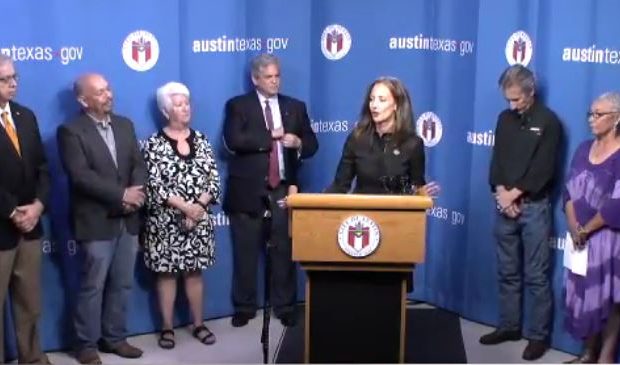Austin teams up with Travis County and AISD on affordable housing
Friday, October 14, 2016 by
Jack Craver The city of Austin, Travis County and the Austin Independent School District are poised to enter a three-party partnership aimed at using publicly owned lands to address the shortage of affordable housing in the area.
City Council did its part Thursday, when it approved a resolution (on its consent agenda) directing the city manager “to explore the economic and legal feasibility of a joint affordable housing project” with the county and school district. The Travis County Commissioners Court and the school district board of trustees must also approve similar measures.
At a press conference following the vote, Mayor Steve Adler described the potential partnership as “another tool” with which the city can provide relief for low-income residents and chip away at Austin’s economic segregation.
“We talk about reinventing the urban school district, and we know that we need to take an active role in reinvesting in our communities, particularly in opportunities that will address affordability issues,” said AISD Trustee Paul Saldaña, who emphasized the plight of families the district serves as well as its 6,000 teachers, who make an average of $48,000 a year and struggle to find housing near the schools where they work.
Council also passed a separate resolution Thursday that directs the city manager to report back to Council in December with three proposed developments that would be on city-owned properties and provide either affordable housing, mixed-use housing developments or emergency shelters.
The resolution does not specify which properties city staff should propose for developments, but it makes note of previous resolutions that directed staff to study the feasibility of housing projects on city-owned parcels located at 411 Chicon St., 6909 Ryan Drive and 4711 Winnebago Lane.
Council Member Leslie Pool noted that she had been working with neighbors in her district to develop a plan for the Ryan Drive property, which is currently owned by Austin Energy and which neighbors hope will be used at least in part for a park, despite the presence of chemical contaminants that will have to be cleaned up.
While Mayor Pro Tem Kathie Tovo, the resolution’s author, emphasized that she wanted the measure to “laser focus” on several properties that staff has already identified as ideal for housing development, she ultimately accepted an amendment offered by Council Member Ann Kitchen that also directed staff to assemble a list by Jan. 1 of all city-owned properties it considers “suitable for development.”
All but one Council member in attendance, Don Zimmerman, supported the gist of the resolution, but its passage was preceded by a conversation about affordable housing that revealed a number of conflicting opinions about where and how the city should encourage the development of units to serve the city’s poor and lower middle class.
Council Member Sheri Gallo said she would like to see more subsidized housing in her West Austin district (District 10), which has the highest median income in the city. She conceded that her district lacks the public transit connections that city planners like to see next to affordable housing developments, but she suggested that transit could follow housing, rather than the other way around. There are a lot of lower-wage jobs in her district that workers are unable to live near because of high housing costs, she said.
Council Member Greg Casar echoed Gallo’s remarks and thanked his colleague for advocating for more low-income housing west of MoPac, a historically affluent area of the city that housing advocates have long claimed has not done its share in providing housing for the poor.
Council Member Delia Garza, whose District 2 in Southeast Austin is also largely outside of core transit corridors, voiced concerns about Gallo’s suggestion. Putting housing outside of transit-heavy areas forces the Capital Metropolitan Transportation Authority to divert resources to serve relatively small populations on the city’s fringes.
“It has made our entire bus system less efficient,” she said. “We’re taking buses off the corridors where we could provide more reliable and frequent service.”
Council Member Ora Houston, whose East Austin district has seen major gentrification in recent years, said that the vision of a “compact and connected” city has been contradicted by the city’s continual expansion through annexations. It is in the newly acquired territory that much of the city’s low-income housing has been built, she said.
“The people we place in those affordable housing units have no way to get into town,” she said.
Zimmerman was the only one uninterested in debating where to place subsidized housing. Instead, he chimed in with his customary denunciation of the very concept and argued that the city should instead be selling its unused properties to the private sector for market-rate housing.
The resolution passed 8-1, with Zimmerman in opposition and Council members Pio Renteria and Ellen Troxclair absent.
The Austin Monitor’s work is made possible by donations from the community. Though our reporting covers donors from time to time, we are careful to keep business and editorial efforts separate while maintaining transparency. A complete list of donors is available here, and our code of ethics is explained here.
You're a community leader
And we’re honored you look to us for serious, in-depth news. You know a strong community needs local and dedicated watchdog reporting. We’re here for you and that won’t change. Now will you take the powerful next step and support our nonprofit news organization?




